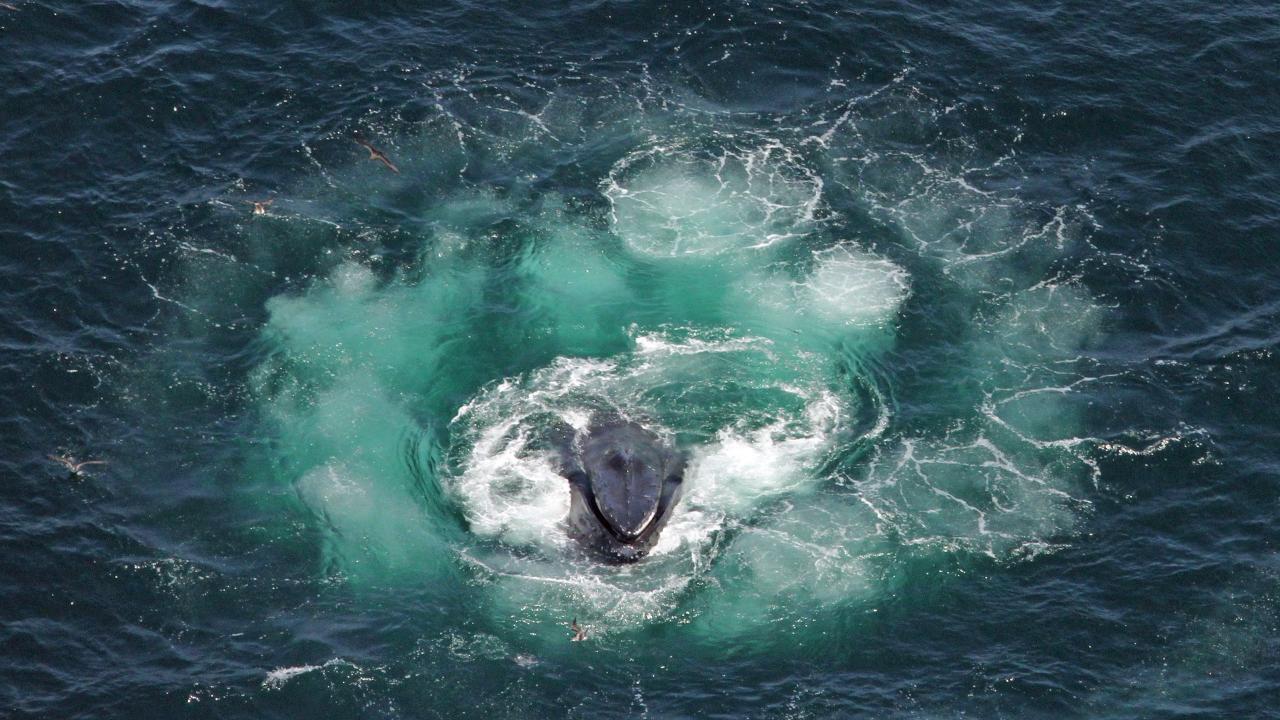The world of whales is an acoustic one. Beneath the water’s surface, visibility is limited. Chirps, clicks, bellows and the like are the language of cetaceans. But what’s being communicated with these utterances is still largely a mystery, one that scientists are eager to unravel.
To crack the code of whale communication, scientists rely on underwater microphones called hydrophones to gain access to the animals’ soundscapes. In aqueous environments, sound travels about five times faster than it does in air. What’s more, acoustic waves face less dissipation in water, traveling farther and differently than in air.
New advances in hydrophone technology spearheaded by a UC Davis scientist are giving us an unprecedented view into the lives of whales. Over the past year, in both southeast Alaska and off the coast of Maui, Hawaii, James Crutchfield, distinguished professor in the Department of Physics and Astronomy at the UC Davis College of Letters and Science, has deployed an advanced prototype underwater microphone to record humpback whale songs and social calls for the first time in three dimensions. The detailed recordings are revealing new nuances to humpback whale behavior and providing scientists with a new way to monitor whale populations.
“The hydroambiphone records the entire spatial field so that you can zoom in, zoom out, pan left and pan right,” said Crutchfield, noting the recordings enable scientists to better pinpoint the location of vocalizing whales. “These whales are obviously talking to each other and interacting, but what are they saying? If we can record these vocalizations in the context of social behaviors, we can start to understand some of the meaning and semantics of the calls.”
(Humpback Chorus recorded during Crutchfield's January 2024 trip to Maui. To hear the spatial sound captured in the ambisonic recording (binaural rendering) use over-ear headphones, not earbuds)
Communication beneath the waves
Crutchfield’s prototype hydroambiphone is a 12-inch diameter, hollow sphere fashioned from stainless steel with four omnidirectional hydrophones mounted to its surface. Crutchfield built the prototype hydroambiphone based on the ambisonic theory of spatial acoustics. In essence, the hydroambiphone employs the theory to create an exact representation of the underwater sound field that’s centered around the device.
“When you have a single hydrophone, like having a single microphone in the air, sounds come from all directions but none of that directional information is available with a single hydrophone,” said Crutchfield.
Crutchfield and his colleagues first tested the prototype hydroambiphone during a 300-mile voyage along the Inside Passage of southeast Alaska in late August 2023. During the expedition, hosted by Don and Denise Bermant, the team followed groups of humpback whales famous for their 'bubble net' collective feeding strategy.
“They get together in a group of two, three, four, sometimes even 10 or 12. A pair of the animals dives down to about 50 to 60 feet in the water and starts swimming in a spiral pattern toward the surface, forming a cylinder of bubbles by expelling air out their blowholes,” said Crutchfield.
The whales use the strategy on krill, herring and other small fish. As the bubble net rises to the surface, it traps the prey within its column. The humpback whales below then open their mouths and swoop upwards, breaching the surface as they feed. But first, there’s a sound cue.
“One of the animals emits a feeding call,” Crutchfield said. “It’s a distinctive up-sweeping pitch that tells the animals waiting below the bubble cylinder that it’s time to feed.”
Advancing a prototype
During the Alaskan voyage, Crutchfield and colleagues successfully logged 70 hydroambiphone recordings, ranging from 10 minutes to one hour in length. According to Crutchfield, the device’s 3D recording of the sound field further revealed the world beneath the waves to the researchers.
“We were regularly surprised at the number of animals around us,” said Crutchfield. “Another general observation was the sheer diversity of humpback social calls and the regularity of apparent acoustic communication.”
The humpback activity was far in excess of the numbers Crutchfield expected from only visual surface observations. With that in mind, he noted the hydroambiphone could be used to gain more accurate population numbers for monitoring species recovery.
Crutchfield is now designing a new hydroambiphone that will increase the number of hydrophones on the device from four to nine, which will greatly improve the spatial detail that can be recorded. Through relationships with hydrophone manufacturers in the Washington area, Crutchfield has also gained access to cutting-edge technology to take his hydroambiphone to the next level.
“It’s going to be more challenging to engineer, but the shops on campus have the necessary machine tools,” he said.
“The theoretical physics — wave mechanics from quantum theory — I’m bringing to bear to understand the propagation of sound in the ocean is just fascinating,” he added.
Media Resources
Whales in Space: Experiencing Aquatic Animals in Their Natural Place with the Hydroambiphone (ArXiv.org)
Greg Watry is a content strategist with the UC Davis College of Letters and Science. A version of this story was originally published on the college's web site.
